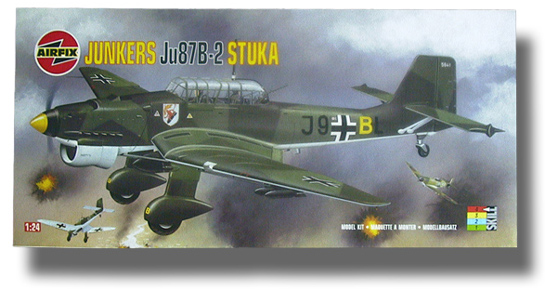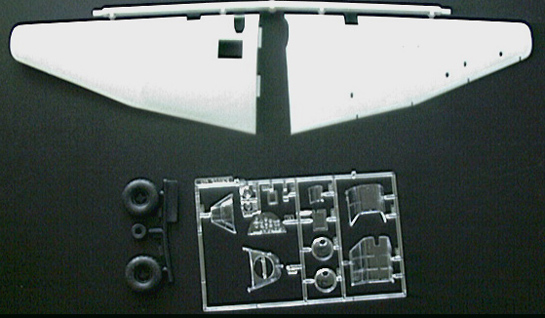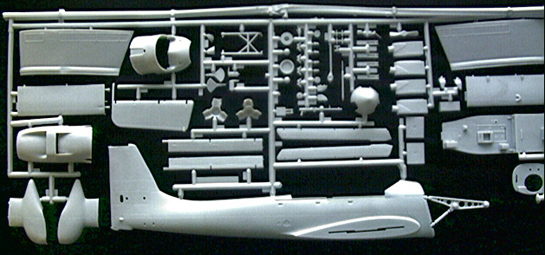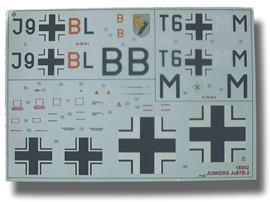Airfix | 1/24th Junkers Ju 87B-2 Stuka
Reviewed by Vernon Rabbetts

The History
In a world of supposedly Precision Guided Munitions (PGM's), Laser Guided Bombs, thermal-seeking missiles etc., ad nauseum, it is sometimes difficult to imagine that it was quite possible for pilots to place a large bomb down the funnel of a manouevering battleship at full steam, with nothing other than stick and rudder.
The art of the dive bomber was reaching it's zenith in 1939 with most major air arms examining the introduction of this technique into their air arms. The successful integration of tactical dive-bombing into ground forces operations had been proven in both Spain and Poland.
The top predator, the alpha male of the Dive Bomber family at the time of this zenith was the JU-87 Stuka. It was the Stuka more than any other aircraft which both proved the validity of dive-bombing and limitations under which it could be undertaken successfully. No other aircraft before and after was able to spread so much disorder to ground troops simply by being heard.
It is only in a time where noise is an ever-present assault on the senses that the idea of a plane screaming as it dived conjures no fear. But for centuries before, people understood in their bones that noise was an effective weapon and method of inducing fear. Look at our western cultural past, where the wailing Banshee, the song of the Siren, Mermaid and Lorelei all portend death and disaster.
The Nazi party understood noise. German cities were blanketed with speakers to broadcast news, the sound of soldiers boots crashing against tarmac as they marched would be recorded for broadcast. Is it any surprise then that their much-vaunted Dive Bomber had wind driven sirens built into the airframe as a weapon? When you read soldiers accounts of German air attacks up until the fall of France, a common theme is the hatred of the Stuka's wail as it dived in for the kill.
The ability of the Stuka to destroy, men, women, children, buildings, infrastructure was legendary by the time the Luftwaffe came to sit on the English Channel. But the lesson had not been learnt, that the Stuka could not successfully operate without Air Superiority. When the Stuka Geschwaders came up against the first fully prepared and integrated air defence system it had ever faced, they were cut to pieces. And thus the Achilles heel, or rather Siegfried's Linden leaf shaped weak spot was revealed. Where the lessons; so bloodily paid for by German pilots; was remembered, the use of this tactic reaped rich rewards. Where it was forgotten, the tactic would only bring a pyhrric victory at best.
The Aircraft
The Ju87B-2 is probably the best known variant of the Stuka family tree. It offers easy conversion to either the long-range R or the projected carrier variant. It was this variant, more than any other which resulted in the re-evaluation of it's tasking by the Luftwaffe as this was the variant, most mauled during the Battle of Britain.
The Kit
The Airfix 1/24th series of aircraft models have been criticised by many, but personally speaking I've always loved them. The Spitfire Mk.1 may have its' problems, but the Hurricane Mk.1, Bf-109E, the P-51D are simple, elegant and easily workable. They produce good representations of the aircraft they represent straight from the box and the "stripability" of engine and gun panels mean that even a beginner can produce a nice kit with no extras.
On top of this, they are great bases from which more advanced modelers can produce show-stopping models. Of the four kits from the series that I have in stock, the Stuka is by far the best, despite my concerns that it would be the worst.
The kit comes in the usual sturdy fibreboard carton with a lift off lid. The artwork on the cover shows a StG 1 Ju-87B-2 flown by Oberleutnant Otto Blumers being attacked by a Spitfire whilst his gunner shows total confidence in the airframe by ignoring the attack totally. Probably explains why they were shot down.
Inside the box, you will find eight sprues or parts. Six of which are in a light grey plastic, one is the clear parts and the last is the ubiquitous vinyl wheels. In addition you get the glossy covered instruction booklet and a relatively small sheet of decals.
Of the six grey plastic sprues four are unbagged and comprise 2 each of fuselage halves and larger components, 2 each of the outer wings and in a separate bag, the smallest and most fragile components. The panel lines are all recessed, some may consider them too recessed, but they work for me. The rivets are a mixture, accurately so, of both recessed and raised. As the finish of the plastic is "slightly" pebbled, some form of sanding of the major components is likely during construction and these raised rivets will lose some of their "obviousness" naturally special attention will not be necessary.

The cockpit straight from the sprues will look pretty good once assembled and painted. The pilots instrument panel comes in the usual two parts and with careful painting will look just fine. There is no provision of belts, again, as per usual with this series but the rest of the cockpit is well if heavily detailed, although the softness of the plastic does make working the parts quite easy. The figures provided are significantly better than those provided with the Mustang, Hurricane and 109; with positionable two part heads, separate arms and torso and legs in two parts split from neck to toes.
This said the application of some Waldron PE parts and belts as well as some good old fashioned stretched sprue, wire and stock plastic card will turn the o.k. into the excellent.
The Jumo engine as always is very well represented and will only require some additional plumbing in the form of solder and wire to make it look very good. One really nice thing is that the engine bearers are part of the fuselage molding and will therefore be stronger than those of the other prop driven kits in the series.
The wing structures break down into six distinct areas. The inner wings, which are extremely straightforward. The outer wing units, which also have the machine gun bays and again should be extremely straightforward. And finally the control surfaces, which are all separate. The flaps and ailerons look fine against the plans I have although the under wing dive brakes could do with some thinning down. The only thing is that the trailing edges may need some thinning out, I say may because I haven't seen Stuka trailing edges in the flesh for a long time and can't say for certain that it is necessary. If it is, you will need to focus on the upper wing components, otherwise, the flap hinges may lose a secure attachment point.
One thing I really like about the kit is the front undercarriage units. Which will allow you to position the units in either an unladen, or laden condition. That is a well thought-out engineering move from Airfix and will help modelers who have an aversion to hacking plastic too much (like me!!) The only thing to be concerned about is the vinyl tyres which have a propensity to eat styrene over a long period. It might be easier to get RTV castings of the tyres for the long-term well being of the kit. If you want to show your Stuka with no-spats, then you've got a heavy scratch-building session ahead of you. But in most photographs, this variant nearly always has its' spats on.

Unfortunately, Airfix still doesn't bag its' transparencies, which is a pity as they are very well molded with clear delineation of the frames, which will making masking significantly easier.

As per usual the biggest let down with the Airfix kit is the decal sheet. Unlike most of the kit's I've seen from this series, the sheet is in register, but the quality and density of the reds used in printing are extremely poor. This has been the case for the Hurricane, the Mustang and the 109 as well. In addition, the swastika (let's call a spade a spade,) has been deleted and replacing this item in 1/24th isn't the easiest of things to do. For me this won't be a problem as I'll do this kit new decals on an ALPS printer, but for other modelers, Airfix could and should come up with a better solution.
Summary
This is a good kit for all modelers at all stages. Even if built by a beginner they will have a fine kit, which will encourage them to build more. This surely is the highest praise that you can give any kit. It does have problems, the vinyl tyres, the decal sheet, the total lack of belts in the cockpit etc., but they are all surmountable.
Overall I'd give this model an 4 out of 5 and say that if you want a Stuka in large scale, more than the Revell kit, this is the one you want. So go buy one like I did, go on…
…what are you still doing there…
…stop reading, go buy the kit…
…yes right now, get out of here…
© Vernon Rabbetts 2002
This review was published on Saturday, July 02 2011; Last modified on Wednesday, May 18 2016
